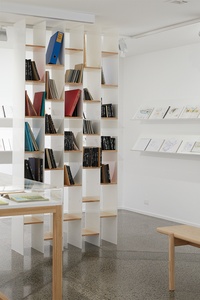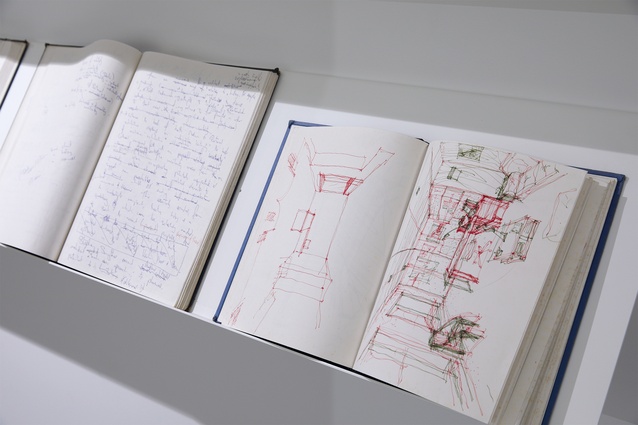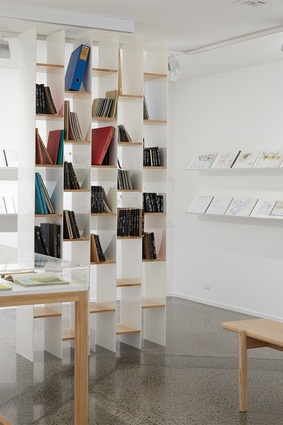Review: Forty Years Drawn: Pete Bossley
Marian Macken visits the Chartwell Gallery at Objectspace and finds an exhibition in appreciation of the physical artefact.
The ways in which we encounter architectural drawings in a gallery space are varied. We may view vertically mounted copies of drawings hung on walls, originals held flat within vitrines, which we bend over to look at closely, or projected imagery, moving animations of space. Pete Bossley’s Forty Years Drawn, which exhibited at Objectspace, offers a different approach to looking at drawings. Here, the room contains books. Yet, these are not holistically designed objects, as are, say, exhibited artists’ books. Instead, this is a personal archive, a library, of one architect’s sketchbooks brought into the public realm.

Each of the four walls of the Chartwell Gallery contains two rows of white, angled shelves, at eye and hand heights, on which these books are displayed. A narrow, tall bookcase in the centre of the room contains more books. All are dated on their spines with white correction fluid. There is no one format of these 197 sketchbooks; there are quarto biology exercise books from the 1970s, pages held together with plastic ring binding in the 1990s and black, landscape-oriented hardcovers, all demonstrating a lack of preciousness regarding paper stock and book form.
Inside these are drawings made with red and black ink, blue biro, pencil, crayon. There are plans, perspectives, landscapes, details, diagrams, portraits, interiors and exteriors. On some pages are glued ephemera from trips: a Paris metro ticket; and entry tickets to the Fondation Le Corbusier and an Ai Weiwei exhibition at Kunsthaus Bregenz. And writing – there are pages and pages of thoughts, musings often written while travelling (‘Reflections on Gehry’; ‘On Context/Exception/Lightness/Awkwardness’).
Included, too, are Bossley’s digital drawings, accessed using an iPad; these, however, are less easy to situate – they are intriguing yet scaleless, undated, but demonstrate a curiosity with shifting media. A recorded interview with Bossley plays on a loop; his voice joins us in the room, narrating his habitual drawing practice.
Within the room, a vitrine holds a collection of sketchbooks featured in Bossley’s recently published book, One Year Drawn. It is a selection from 1982, a year Bossley spent travelling and drawing; the published book is an edited compilation of this time. These books are sealed within a case, which highlights their sectioning off as a subset within an ongoing practice; with hindsight, these are seen as particularly important since they were produced during a transformative time. The rest of the exhibition then tells us about the before and after to this year; the multitudes of unedited originals give a context to the journey One Year Drawn recounts and tell us what happened next.
The pages of the exhibited sketchbooks hold drawings that are documenting and proposing, recording and wondering. For Bossley, the page is waiting – to hold the marks of this architect. On these pages is where he works things out through drawing. Bossley is drawing in order to understand; he is interpreting, discovering and revealing. Hence, the page is his site, since, as the late Robin Evans succinctly said: “Architects don’t make buildings; they make drawings.” Bossley’s work demonstrates an architect who is “building the drawing rather than drawing the building”, as Jonathan Hill writes.
These books ask to be picked up and examined, dipped into, read; we look through books of drawings. Mexican book artist Ulises Carrión refers to the collection of a book’s pages as “a sequence of spaces”. In reading these books, which manifest Bossley’s decades-long practice of drawing, we enter the spaces of Bossley’s design process. The drawings are reflective and yet also propositional and generative. They contain links, and join the dots, between his buildings, both built and unbuilt. These bound pages then offer a chronological narration through a career.
For many years, the question “Is the book dead?” has been raised with predictable regularity, implying a demise or a digital response. An exhibition such as this, in a year which saw public libraries and bookshops unthinkably closed, highlights the continued appreciation of the physical artefact. Here, the book is presented as a tool of the architect: the holder of pages where drawing happens. These books sit before, beside, amongst and after buildings, reasserting the ongoing connection between books and the discipline.











